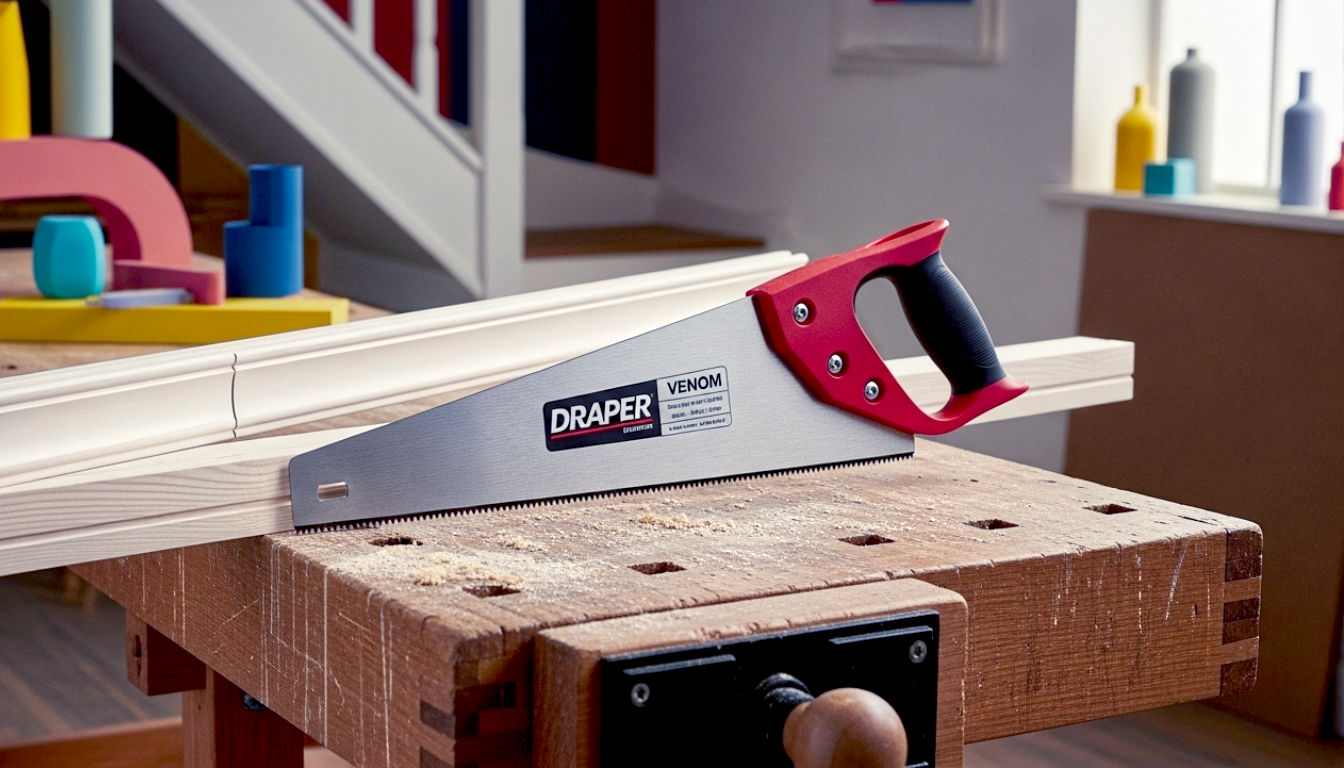The Draper Venom Second Fix Handsaw: The UK Review for DIYers and Pros
We put the popular Draper Venom VST350 second-fix toolbox saw to the test. Discover if its triple-ground teeth and compact size make it a must-have tool.

This post may contain affiliate links. If you make a purchase through these links, we may earn a commission at no additional cost to you.
There’s a special kind of magic in a good handsaw. In a world of screaming power tools, the quiet, rhythmic shush-shush of a sharp blade slicing through wood is one of life’s simple, satisfying pleasures. It connects us to a long history of British craftsmanship, from the shipwrights of Portsmouth to the cabinet makers of High Wycombe. A reliable handsaw isn’t just a tool; it’s a partner in creation.
But finding the right one can be a bit of a faff. Walk into any UK tool shop, and you’re faced with a wall of options. Long ones, short ones, saws with angry-looking teeth and saws with fine ones. So, where do you start?
-
Features a 1mm rigid, high-quality carbon steel blade for stability and precise, straight cuts.
-
The blade has a lacquered coating to reduce friction, enabling powerful and smooth cutting action with its 12 PPI (Points Per Inch) design.
-
Double-ground, hardened, and tempered teeth ensure fine and fast cutting on various types of wood and plastic.
-
An ergonomic, comfort-grip handle is designed to reduce fatigue and enhance user convenience.
-
Engineered for high-quality performance, offering consistent, quick, and fine cuts.
Today, we’re getting up close and personal with a saw that many British DIYers and tradespeople have in their tool bags: the Draper Venom Second Fix Triple Ground Handsaw (VST350). It’s a compact, affordable saw that promises precision and performance. But does it live up to the hype?
This isn’t just another quick review. We’re going to pull this tool apart—metaphorically, of course. We’ll dive into what “Second Fix” and “Triple Ground” actually mean, put the saw through its paces on real-world jobs, and see if it deserves a place in your toolbox. Whether you’re fitting out a new kitchen in Kettering or just trimming a shelf in your London flat, stick with us. This is the definitive guide.
Who Are Draper Tools? A Quick Look at a British Favourite
Before we talk about the saw, let’s talk about the name on the blade. If you’ve spent any time in a British garage or workshop, you’ve seen the name Draper. It’s as familiar as a cup of tea on a chilly morning.
Draper Tools isn’t some faceless corporation. It’s a family-run company with roots stretching back over a century. It all started in 1919 when Bert Draper founded the company, selling surplus government tools and engineering equipment. From those humble beginnings in Kingston upon Thames, Draper has grown into a British institution.
For generations, they’ve been the go-to brand for quality, reliable tools that don’t cost the earth. They’re not always the flashiest, but they’re known for making solid, dependable gear that gets the job done. From spanners and socket sets to garden forks and, yes, handsaws, Draper has equipped countless British sheds and workshops.
So, when you pick up a Draper tool, you’re holding a piece of that history. It’s a brand that understands the needs of the British tradesperson and the weekend DIY warrior alike. This heritage is important because it sets a certain expectation of quality and no-nonsense performance. Does the Venom handsaw live up to it? Let’s find out.
Unboxing the Venom: First Impressions
The Draper Venom VST350 is what’s known as a toolbox saw. The first thing you notice is its size. With a 350mm (or 14-inch) blade, it’s shorter than a standard panel saw. This isn’t a flaw; it’s a feature. It’s designed to be compact enough to slip into a tool bag without sticking out, making it perfect for jobs on the go.
The Handle: Comfort and Control
Your hand naturally finds the handle, which is made from a tough, bright red and black plastic. It feels chunky and substantial. Draper calls it an ergonomic comfort grip, which is a fancy way of saying it’s shaped to fit your hand comfortably and stop it from getting tired. The handle is moulded with softer, grippy sections right where your fingers and palm rest, which gives you a real sense of control.
A neat, traditional feature is the handle’s shape. The top is squared off at a perfect 90 degrees to the blade’s top edge, and the front is angled at 45 degrees. This is a clever little design trick that’s been on handsaws for donkeys’ years. It means you can use the handle itself as a makeshift square to mark out right angles and mitres on a piece of timber. It’s not as accurate as a proper try square, but for a quick mark, it’s incredibly handy.
The Blade: The Business End
Now for the main event: the blade. It’s made from 1mm thick carbon steel, which feels reassuringly rigid. A flimsy, flexible blade is a nightmare to cut straight with, but the Venom’s blade has very little wobble. This stiffness is crucial for making accurate, precise cuts.
The blade also has a lacquered coating. This isn’t just for looks. It helps protect the steel from rust and reduces friction as you saw. Less friction means the saw glides more easily through the wood, so you don’t have to work as hard. It’s a small detail, but it makes a difference.
Overall, the first impression is positive. It feels like a well-made, solid tool. It’s light enough to use all day but has enough heft to feel like it means business. The balance between the handle and blade feels just right. But the real test of a saw isn’t how it feels in your hand; it’s how it cuts.
Decoding the Jargon: What Does “Second Fix Triple Ground” Actually Mean?
The name of this saw is a bit of a mouthful. But those words—”Second Fix” and “Triple Ground”—are the keys to understanding what this saw is designed for and why it should cut so well. Let’s break them down in plain English.
First Fix vs. Second Fix: A Tale of Two Jobs
In the building trade, jobs are often split into two stages: first fix and second fix.
- First Fix is the rough, structural stuff. Think building the timber frame of a house, putting in floor joists, or fitting a roof. For these jobs, you need to cut large pieces of wood quickly. The finish doesn’t have to be perfect because it’ll all be covered up later. Saws for this work (first-fix saws) have big, aggressive teeth (a low TPI) that rip through wood at speed.
- Second Fix is all the finishing work that makes a house a home. This includes fitting skirting boards, hanging doors, adding architrave around doorways, and building shelves. Here, precision is everything. The cuts need to be clean, smooth, and accurate because they’ll be on display.
The Draper Venom is a second-fix saw. It’s designed for those delicate finishing jobs. This is reflected in its teeth.
The Magic of the Teeth: Understanding TPI and Triple Ground
The “sharp end” of the saw tells you everything you need to know about its purpose.
TPI / PPI: The Secret to a Smooth Finish
You’ll see the blade marked with 12 PPI. This stands for Points Per Inch. Sometimes you’ll see TPI, which means Teeth Per Inch. They’re very similar (PPI is always one more than TPI), but they both measure how many teeth are packed into each inch of the blade.
A saw with a low PPI (say, 7 or 8) has fewer, larger teeth. It cuts very quickly but leaves a rough finish. A saw like the Venom, with a high PPI of 12, has lots of small teeth. This means it cuts a bit slower, but the finish it leaves is much cleaner and smoother, with less splintering. This is exactly what you want for second-fix work.
Triple Ground: The Cutting Edge of Saw Technology
This is where things get clever. For centuries, the teeth on British handsaws were simple triangles, filed to be sharp. They only cut in one direction: the push stroke.
Modern saws like the Venom use a much more advanced tooth design. “Triple Ground” means that each tooth has been ground with three separate cutting edges.
Imagine a single saw tooth.
- The front edge is sharpened.
- The top edge is sharpened.
- The back edge is sharpened.
This complex geometry turns each tooth into a tiny, super-efficient knife. It means the saw cuts on both the push and the pull stroke. This has two massive benefits:
- It cuts much faster than an old-school saw because every movement is a cutting movement.
- It’s easier to start a cut. You don’t get that horrible ‘juddering’ as you try to get the saw going. It bites into the wood almost instantly.
So, when you combine the high 12 PPI with the Triple Ground teeth, you get a saw that’s designed to start easily, cut quickly, and leave a silky-smooth finish. That’s the theory, anyway.
Putting it to the Test: The Draper Venom in Action
Theory is all well and good, but the proof is in the pudding—or in this case, the pile of sawdust. We tested the Draper Venom on a range of materials you’d find in a typical British home renovation project.
Project 1: Cutting Skirting Boards
This is the bread and butter for a second-fix saw. We needed to cut some pine skirting for a bedroom.
- Starting the Cut: The triple-ground teeth made starting the cut an absolute doddle. Using a thumb as a guide, the saw bit into the edge of the wood on the very first pull. There was no skipping or jumping, just a clean, immediate start. This is a huge plus, especially when you’re trying to follow a precise pencil line.
- The Cut: Once it got going, the saw moved through the 18mm thick pine with impressive speed. The thin, rigid blade was easy to keep straight, and the lacquered coating seemed to do its job, letting the saw glide smoothly. The push-pull cutting action felt efficient and powerful for such a small saw.
- The Finish: This is where a second-fix saw earns its stripes. The finish left by the Venom was excellent. The cut edge was sharp and clean, with minimal splintering or “tear-out.” It was smooth enough that it needed only the lightest touch with sandpaper before painting. For mitre cuts that need to join perfectly, this level of clean cutting is essential.
Project 2: Trimming a Plywood Sheet
Next, we tried it on a sheet of 12mm plywood. Plywood can be tricky, as the alternating layers of wood grain can cause saws to wander and splinter the delicate top veneer.
- Performance: The Venom handled the plywood well. Again, it started cleanly. It required a bit more effort to cut through the plywood compared to the pine, which is to be expected. The key was to let the saw do the work and not force it. By maintaining a steady rhythm, we were able to make a long, straight cut without the blade straying from the line.
- Finish Quality: The finish was good, but not perfect. There was a small amount of splintering on the top surface, especially on the up-stroke. This is a common issue when cutting plywood with any handsaw. A good tip is to score the cut line with a Stanley knife first or place masking tape along the line to help reduce tear-out. Overall, for a handsaw, the result was more than acceptable.
Project 3: Cutting Plastic Pipe
The product description says the saw can handle plastic, so we tested it on a piece of 40mm plastic waste pipe.
- Performance: The saw zipped through the plastic pipe in seconds. The fine teeth are perfect for this kind of material, as they don’t snag or crack the plastic like a more aggressive saw might. The cut was quick, clean, and left a neat edge that only needed a quick tidy-up with a file.
A Note on the Mixed Reviews: The Quality Control Question
It’s important to be honest. If you look online, you’ll see some users have had a less-than-perfect experience with this saw. The most common complaints are about the saw “dragging” or feeling like it’s fighting the wood, and some have mentioned that the teeth seem incorrectly set.
This suggests there might be some inconsistency in manufacturing. The model we tested was excellent, but it seems a small number of faulty ones might slip through quality control. One user reported returning their first saw and receiving a replacement that worked perfectly.
Our advice? Buy from a reputable seller with a good returns policy (like Amazon or a major UK DIY store). When you get your saw, inspect the teeth to make sure they look uniform. And most importantly, make a few test cuts. If it doesn’t feel right, don’t hesitate to exchange it. The good version of this saw is fantastic; just be aware that you might need to be persistent to get one.
The Ideal User: Who is the Draper Venom For?
So, who should buy this saw? It’s a versatile little tool, but it really shines for specific users and tasks.
- The Home DIY Enthusiast: This is the perfect saw for anyone who enjoys DIY around the house. Whether you’re putting up shelves, building flat-pack furniture, or tackling a bigger project like a new kitchen, the Venom’s combination of a fine finish and compact size makes it incredibly useful. It’s a massive step up from the cheap, basic saw that comes in many starter toolkits.
- The Apprentice Carpenter or Joiner: For someone starting in the trade, the Venom is an excellent, affordable choice. It’s ideal for all the second-fix jobs an apprentice will be learning, like fitting architraves and skirting. Its small size means it’s easy to carry around on a busy site, and it’s a great way to master the fundamentals of handsawing before moving on to more specialised (and expensive) tools.
- The Professional Tradesperson: For a seasoned pro, the Venom probably won’t be their main saw. They’ll likely have a premium panel saw for bigger jobs. However, the Venom makes an absolutely brilliant backup saw. Because it fits so easily in a tool bag, it’s always there when you need to make a quick, clean cut and don’t want to walk back to the van to get your big saw. It’s perfect for those little snagging jobs at the end of a project.
The Competition: How Does the Venom Stack Up?
The Draper Venom doesn’t exist in a vacuum. The UK market for toolbox saws is competitive. Here’s how it compares to a couple of other popular choices:
- Spear & Jackson B9814 Toolbox Saw: Spear & Jackson is another heritage brand with a superb reputation. Their equivalent saw is often priced similarly to the Draper. It also features a fine-toothed blade and a comfortable handle. Many professionals swear by Spear & Jackson, and their quality is generally very consistent. The choice between the two often comes down to personal preference on handle feel.
- Bahco 244-14-U7/8-HP PrizeCut Toolbox Saw: Bahco is a premium Swedish brand, and their saws are legendary in the trade. The PrizeCut is known for its exceptionally sharp, hardpoint teeth that stay sharp for a very long time. It often costs a few pounds more than the Draper, but many would argue you’re paying for superior blade technology and longevity.
- Irwin Jack 880 Universal Toolbox Saw: Irwin is another big name, and their Jack saws are hugely popular. The 880 Universal is designed to be a great all-rounder, cutting reasonably quickly while still leaving a decent finish. It might not be as specialised for fine second-fix work as the Draper, but it’s a very capable and reliable alternative.
Where does the Draper Venom fit in? It sits comfortably in the “excellent value for money” category. It offers performance features (like the triple-ground teeth) that you find on more expensive saws, but at a price point that’s accessible to everyone. While it might suffer from occasional quality control issues, a good one can perform just as well as saws costing twice as much.
The Final Verdict: Is the Draper Venom Worth Your Money?
After spending time with the Draper Venom VST350, we can give a clear recommendation.
Yes, the Draper Venom Second Fix Handsaw is an excellent tool and is absolutely worth the money, providing you get a good one.
Let’s summarise the pros and cons:
The Good:
The Not-So-Good:
Ultimately, this saw represents what Draper does best: it delivers solid performance and thoughtful features at a price that makes you smile. For the British DIYer, it’s a tool that can elevate your projects from “homemade” to “hand-crafted.” For the apprentice, it’s a reliable learning partner. And for the pro, it’s the handy little problem-solver you’ll be glad to have in your bag.
It’s a sharp, clever, and convenient little saw that punches well above its weight. If you’re in the market for a new toolbox saw, the Draper Venom should be at the very top of your list.
Further Reading and Resources
To continue your journey into the world of woodworking and quality tools, here are some highly respected resources:
- The Draper Tools Official Website: Explore the full range of tools and the company’s history.
- The English Woodworker Blog: A fantastic resource for traditional woodworking techniques, run by Richard Maguire.
- UK Workshop Forum: A bustling online community of British woodworkers and DIYers, full of advice and project inspiration.







